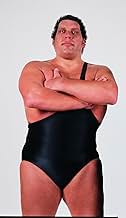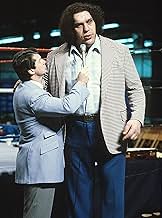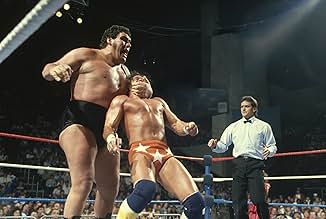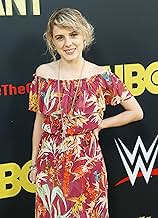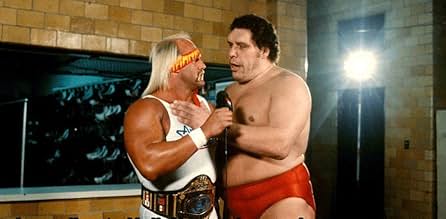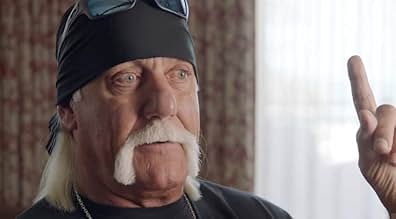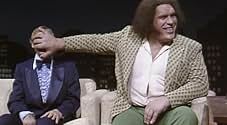Agrega una trama en tu idiomaA look at the life and career of professional wrestler André Roussimoff, who gained notoriety in the 1980s as Andre the Giant.A look at the life and career of professional wrestler André Roussimoff, who gained notoriety in the 1980s as Andre the Giant.A look at the life and career of professional wrestler André Roussimoff, who gained notoriety in the 1980s as Andre the Giant.
- Premios
- 1 nominación en total
Jesse Ventura
- Jesse Ventura
- (material de archivo)
Roddy Piper
- Rowdy Roddy Piper
- (material de archivo)
André René Roussimoff
- Andre the Giant
- (material de archivo)
- (as André the Giant)
Cyndi Lauper
- Self
- (material de archivo)
Andy Warhol
- Self
- (material de archivo)
Bob Uecker
- Self
- (material de archivo)
Randy Savage
- Macho Man Randy Savage
- (material de archivo)
Muhammad Ali
- Self
- (material de archivo)
David Letterman
- Self
- (material de archivo)
Bobby Heenan
- Self
- (material de archivo)
Argumento
¿Sabías que…?
- TriviaVince McMahon announced this documentary in 2016.
- Citas
Cary Elwes: That's the first question they ask me, wasn't it fun to go drinking with Andre. Cause they think of him as this legendary drinker and they think it's funny, but in fact he drank because he was in pain. And I asked him one day and he explained to me that his spine and his neck and his knees gave him lots of trouble.
- ConexionesFeatures WrestleMania III (1987)
- Bandas sonorasIt's Truth We Seek
Music Written & performed by Rhian Sheehan
Opinión destacada
On March 29, 1987, the most significant pro-wrestling match of all time took place at WrestleMania III (1987) in the Pontiac Silverdome, in front of 93,173 fans and millions watching around the world, as Hulk Hogan (the greatest of all time then and the greatest of all time now) defended his world heavyweight title against his former best friend, André René Roussimoff. The whole thing was a perfect storm of an expanding and rabid fan base, a company that had gone from territorial to national to international in just a few years, advertising acumen, talent with charisma to burn, and, most importantly, genuine emotion - Hogan had been betrayed by his oldest and closest friend, a man who had grown bitter and resentful of Hogan's success, and who now wanted Hogan's title from him, a title he had held since January 1984. It's not the greatest contest of all time; for a WrestleMania main event, it's very short (12 minutes), with Hogan extremely restricted as to what he could do with André, whose mobility was severely compromised and who was in immense pain due to the effects of acromegaly. But it didn't matter, because the match culminated with Hogan doing the impossible and slamming André. It's rare in pro-wrestling when a babyface champion goes into a match as the underdog, but that was exactly what had happened here, making Hogan's victory all the more significant.
Which brings us to Jason Hehir's excellent documentary on André for HBO, the emotional high-point of which is the WrestleMania III match with Hogan. Sure, it's not always successful in its attempts to separate the man from the myth, falling back far too often on the very hyperbolic mythological elements it's trying to sidestep, and it's neither as insightful nor as objective as one might wish - it was made in association with WWE, which makes objectivity pretty much impossible, and there's next to nothing here you couldn't find online. However, it's respectful, informed, and entertaining, avoiding, for the most part, hagiography, and featuring some superb archival footage, providing a not-always-uplifting window into the life of a man for whom the term "gentle giant" could very well have been coined.
Born André René Roussimoff in 1946 in Molien, France, André began to display signs of gigantism at around 10, and by age 12, he was already 6ft 3in and 208lbs. He started working as a pro-wrestler in 1964, and soon became a huge draw anywhere he went. Fast forward to WrestleMania III in 1987, André's gigantism had developed into acromegaly, as he continued to grow, putting huge pressure on his joints, which caused him constant pain. Semi-retired, he had trouble even walking. However, WWF owner Vince McMahon pitched a storyline which would see André turn heel for the first time in his career and challenge Hogan for the title. The resulting match was instantly iconic, not just in the pro-wrestling sphere, but in pop culture generally. That same year, André appeared in El pirata y la princesa (1987) as Fezzik, a gentle giant with a penchant for rhyming. Refusing all treatment for his acromegaly as he felt it would interfere with his career and diminish his persona, he continued to wrestle on and off for the next five years, as his health continued to decline. He died in his sleep of congestive heart failure on January 27, 1993.
The film is composed entirely of archival footage and talking-head interviews, with Hehir choosing not to employ a narrator, effectively allowing the interviewees to tell the story. During pre-production, Hehir and producer Bill Simmons decided to include only material which had been directly witnessed; there was to be nothing anecdotal. As Hehir explains it, "we were only going to have first-person accounts. So, if someone said, "I heard André drank 156 beers," well, were you there? If you weren't, it's not gonna make it in. But when Ric Flair says "he drank 106 beers in front of me", that makes it in." This affords the documentary a sense of personalised intimacy - every interviewee is talking about things they actually saw rather than things about which they heard - which, in turn, works towards Hehir's mission statement of depicting the man rather than the myth.
In this respect, one of the most important sections in the film is the disappointingly brief depiction of his time in his adopted home of Ellerbe, NC. Interviewing his daughter, who spent time with him on his ranch, and a few neighbours, this is where Hehir is most successful in dividing the man from the mythos. André loved living there because he could be himself and because he was left alone - he could go to the shop without people gawking at him or asking for autographs, he could be a regular citizen. This comes in the middle of a section about how logistically difficult André's life was (as Flair points out, he couldn't put on a disguise and stroll around New York or go to a movie, and as Hogan explains, everything was too small for him, rendering mundane tasks such as eating in a restaurant hugely difficult). The Ellerbe material really gives the impression that, outside his native France, this was where he was happiest. It's one of the most low-key, moving, and human parts of the documentary, and it's perhaps the only section from which hyperbole seems entirely absent.
Another rather moving section concerns the making of The Princess Bride. Anyone familiar with the film will already know everything covered in this section, but many wrestling fans will not. In a direct rejoinder to colleagues who humorously extol his legendary drinking, Cary Elwes points out that the reason André drank so much was that he was perpetually in so much pain. Along the same lines, director Rob Reiner and actress Robin Wright discuss how surprised they were at how difficult André found it to perform even the simplest physical tasks. There's the famous shot, for example, where Westley (Elwes) jumps on Fezzik's back, and Fezzik slams them both into a boulder, a scene which employs one of the most obvious stunt doubles ever seen, as André was unable to shoot the scene himself. Even more revealing is the scene where he catches Buttercup (Wright) as she falls from a tower, a scene which had to be shot with Wright supported on wires because André couldn't hold her weight. This man who routinely tossed 300lb opponents around the ring couldn't support the weight of a single woman.
In this sense, although the tone is never melancholy, André's story does emerge as something of a tragedy - not because he failed to achieve his dreams, but because in doing so, he dissuaded himself from availing of the aid that could have lengthened his life, and would certainly have eased his suffering.
In terms of problems, the most egregious is Hehir's failure (for the most part) to disentangle André Roussimoff from André the Giant. Hogan, Flair, McMahon, and André's closest friend, Tim White all talk about the man behind the persona, but none can claim to have known him before he became André the Giant. This is why the Ellerbe section and the brief material on his life in France are so important, as they speak to who he actually was rather than who we believe him to be. So although Hehir does avoid hagiography, he fails to demythologise, with so many of the (probably hyperbolic) stories told by the interviewees fitting more comfortably into the image of André the Giant than the life of André Roussimoff. Additionally, more than likely due to the WWE's direct involvement with the project, there's nothing even remotely negative said about the company, although Hogan does point out that, come WrestleMania III, André probably shouldn't have been in the ring. The implication is that McMahon may have exploited André's passion for the business, but this fascinating theme is buried under more mythologising and is quickly forgotten. There's certainly a documentary to be made about André's later years, about his inability to leave the spotlight, about his lack of interest in self-preservation, but this is not that documentary.
Nevertheless, this is a very fine tribute. André was vitally important to an industry at a pivotal crossroads, and the film captures why he was such a compelling character, able to elicit pathos (and later antagonism) from wrestling audiences the world over with relative ease.
Which brings us to Jason Hehir's excellent documentary on André for HBO, the emotional high-point of which is the WrestleMania III match with Hogan. Sure, it's not always successful in its attempts to separate the man from the myth, falling back far too often on the very hyperbolic mythological elements it's trying to sidestep, and it's neither as insightful nor as objective as one might wish - it was made in association with WWE, which makes objectivity pretty much impossible, and there's next to nothing here you couldn't find online. However, it's respectful, informed, and entertaining, avoiding, for the most part, hagiography, and featuring some superb archival footage, providing a not-always-uplifting window into the life of a man for whom the term "gentle giant" could very well have been coined.
Born André René Roussimoff in 1946 in Molien, France, André began to display signs of gigantism at around 10, and by age 12, he was already 6ft 3in and 208lbs. He started working as a pro-wrestler in 1964, and soon became a huge draw anywhere he went. Fast forward to WrestleMania III in 1987, André's gigantism had developed into acromegaly, as he continued to grow, putting huge pressure on his joints, which caused him constant pain. Semi-retired, he had trouble even walking. However, WWF owner Vince McMahon pitched a storyline which would see André turn heel for the first time in his career and challenge Hogan for the title. The resulting match was instantly iconic, not just in the pro-wrestling sphere, but in pop culture generally. That same year, André appeared in El pirata y la princesa (1987) as Fezzik, a gentle giant with a penchant for rhyming. Refusing all treatment for his acromegaly as he felt it would interfere with his career and diminish his persona, he continued to wrestle on and off for the next five years, as his health continued to decline. He died in his sleep of congestive heart failure on January 27, 1993.
The film is composed entirely of archival footage and talking-head interviews, with Hehir choosing not to employ a narrator, effectively allowing the interviewees to tell the story. During pre-production, Hehir and producer Bill Simmons decided to include only material which had been directly witnessed; there was to be nothing anecdotal. As Hehir explains it, "we were only going to have first-person accounts. So, if someone said, "I heard André drank 156 beers," well, were you there? If you weren't, it's not gonna make it in. But when Ric Flair says "he drank 106 beers in front of me", that makes it in." This affords the documentary a sense of personalised intimacy - every interviewee is talking about things they actually saw rather than things about which they heard - which, in turn, works towards Hehir's mission statement of depicting the man rather than the myth.
In this respect, one of the most important sections in the film is the disappointingly brief depiction of his time in his adopted home of Ellerbe, NC. Interviewing his daughter, who spent time with him on his ranch, and a few neighbours, this is where Hehir is most successful in dividing the man from the mythos. André loved living there because he could be himself and because he was left alone - he could go to the shop without people gawking at him or asking for autographs, he could be a regular citizen. This comes in the middle of a section about how logistically difficult André's life was (as Flair points out, he couldn't put on a disguise and stroll around New York or go to a movie, and as Hogan explains, everything was too small for him, rendering mundane tasks such as eating in a restaurant hugely difficult). The Ellerbe material really gives the impression that, outside his native France, this was where he was happiest. It's one of the most low-key, moving, and human parts of the documentary, and it's perhaps the only section from which hyperbole seems entirely absent.
Another rather moving section concerns the making of The Princess Bride. Anyone familiar with the film will already know everything covered in this section, but many wrestling fans will not. In a direct rejoinder to colleagues who humorously extol his legendary drinking, Cary Elwes points out that the reason André drank so much was that he was perpetually in so much pain. Along the same lines, director Rob Reiner and actress Robin Wright discuss how surprised they were at how difficult André found it to perform even the simplest physical tasks. There's the famous shot, for example, where Westley (Elwes) jumps on Fezzik's back, and Fezzik slams them both into a boulder, a scene which employs one of the most obvious stunt doubles ever seen, as André was unable to shoot the scene himself. Even more revealing is the scene where he catches Buttercup (Wright) as she falls from a tower, a scene which had to be shot with Wright supported on wires because André couldn't hold her weight. This man who routinely tossed 300lb opponents around the ring couldn't support the weight of a single woman.
In this sense, although the tone is never melancholy, André's story does emerge as something of a tragedy - not because he failed to achieve his dreams, but because in doing so, he dissuaded himself from availing of the aid that could have lengthened his life, and would certainly have eased his suffering.
In terms of problems, the most egregious is Hehir's failure (for the most part) to disentangle André Roussimoff from André the Giant. Hogan, Flair, McMahon, and André's closest friend, Tim White all talk about the man behind the persona, but none can claim to have known him before he became André the Giant. This is why the Ellerbe section and the brief material on his life in France are so important, as they speak to who he actually was rather than who we believe him to be. So although Hehir does avoid hagiography, he fails to demythologise, with so many of the (probably hyperbolic) stories told by the interviewees fitting more comfortably into the image of André the Giant than the life of André Roussimoff. Additionally, more than likely due to the WWE's direct involvement with the project, there's nothing even remotely negative said about the company, although Hogan does point out that, come WrestleMania III, André probably shouldn't have been in the ring. The implication is that McMahon may have exploited André's passion for the business, but this fascinating theme is buried under more mythologising and is quickly forgotten. There's certainly a documentary to be made about André's later years, about his inability to leave the spotlight, about his lack of interest in self-preservation, but this is not that documentary.
Nevertheless, this is a very fine tribute. André was vitally important to an industry at a pivotal crossroads, and the film captures why he was such a compelling character, able to elicit pathos (and later antagonism) from wrestling audiences the world over with relative ease.
- Bertaut
- 21 sep 2019
- Enlace permanente
Selecciones populares
Inicia sesión para calificar y agrega a la lista de videos para obtener recomendaciones personalizadas
Detalles
- Fecha de lanzamiento
- País de origen
- Sitio oficial
- Idiomas
- También se conoce como
- Андрэ Гигант
- Productoras
- Ver más créditos de la compañía en IMDbPro
- Tiempo de ejecución1 hora 25 minutos
Contribuir a esta página
Sugiere una edición o agrega el contenido que falta

Principales brechas de datos
What is the French language plot outline for Andre the Giant (2018)?
Responda




